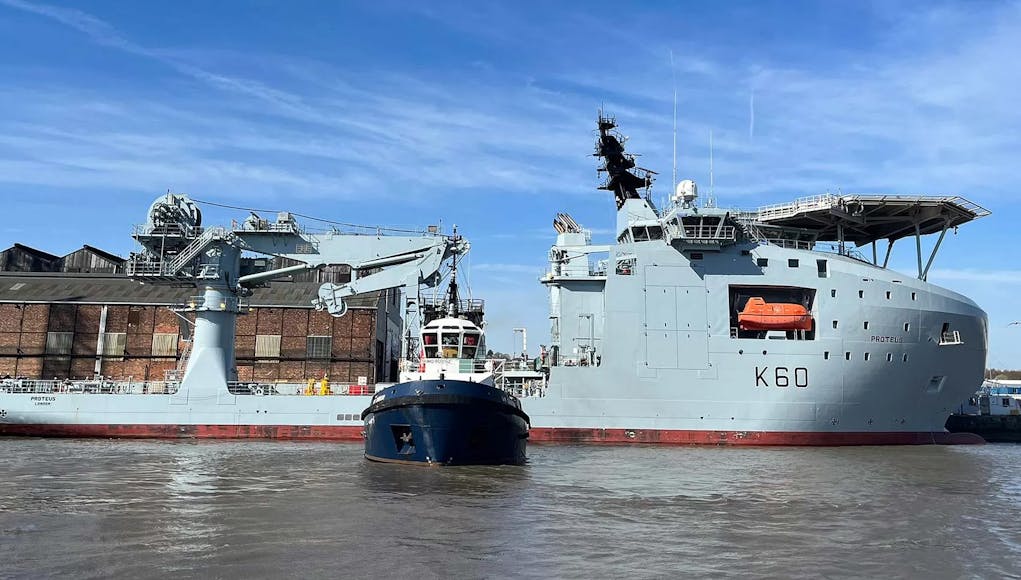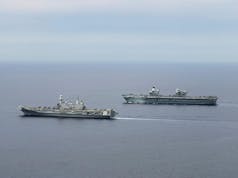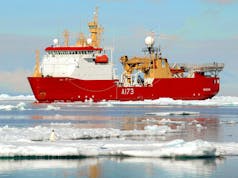In a research briefing titled “Seabed Warfare: Protecting the UK’s Undersea Infrastructure”, published on 24 May 2023, Louisa Brooke-Holland of the House of Commons Library outlines the significance of the UK’s undersea infrastructure and the measures taken to protect it against potential threats.
Brooke-Holland emphasises the importance of undersea cables and pipelines, which are integral to the UK’s critical national infrastructure.
She states, “On the seabed lie miles of telecommunication cables that enable internet access, financial transactions and the sharing of data essential to business and personal life.”
According to the Ministry of Defence, “99% of global internet traffic goes through undersea cables.” Furthermore, “Seabed gas and oil pipelines provide essential energy supplies to the UK; 77% of all of the UK’s gas imports came from Norway through pipelines lying under the North Sea.”
The briefing introduces the concept of seabed warfare, which predominantly concerns undersea warfare with a focus on the seabed. The European Parliament has highlighted the vulnerability of undersea cables and pipelines and warned of the “potential for sabotaging undersea cables during times of conflict.” Brooke-Holland notes that advances in underwater technology have made seabed exploration more accessible and that, according to a NATO Parliamentary Assembly committee draft report, seabed warfare now “represents an immediate and legitimate threat.”
Russia is identified as a key threat in the briefing. The UK Government, in a 2021 defence report, mentioned that Russia is developing “deep sea capabilities which can threaten undersea cables.” The French Government also expressed concerns, stating that Russia has been “upscaling in the field of seabed warfare” and is “very active in everything related to underwater combat.” In May 2023, a senior NATO official stated that Russia is “actively mapping gas pipelines and internet cables.”
In response to these threats, Brooke-Holland reports that the Ministry of Defence accelerated the procurement of a new surveillance ship, RFA Proteus, which is “expected to begin operating in summer 2023.” The ship is a converted merchant vessel capable of operating remote and autonomous underwater systems and will be “operated by the Royal Fleet Auxiliary, which is the civilian branch of the Royal Navy, supported by Royal Navy specialists.”
Brooke-Holland also sheds light on international collaborations and agreements in response to the threats. For instance, the UK and Norway agreed on 18 May 2023 to develop a strategic partnership “to counter shared threats in the undersea domain.” Furthermore, the UK is collaborating with Australia and the United States under the AUKUS agreement to develop undersea capabilities.
The briefing concludes by looking at what NATO and other countries are doing in response to the growing threat. For instance, in February 2023, NATO established a Critical Undersea Infrastructure Coordination Cell at its headquarters to “boost the security of Allied undersea infrastructure.” Additionally, in March 2023, the European Commission updated its Maritime Security Strategy, committing to “promote the development of capabilities for securing critical seabed infrastructure by 2024.”














At long last the west is waking up to the fact that Russia has Historically emphasised their underwater war fighting capabilities. Sometimes they have got it glaringly wrong and sometimes the have excelled.
The RN is going down the Civilian cross over path with RFA Proteus to acquire capacity quickly and not waiting for a purpose built ship. And given the habit of the services to add bells and whistles to anything they touch I can understand why.
It’s a great bit of OOTB thinking and I think they may just have nailed it, but I wonder if it is possible to leverage this idea for something larger.
NATO as a body operates a fleet of E3 AEW aircraft via the NAEW&C, it provides all of NATO with AEW oversight of our airspace.
So if Proteus works why not get NATO to establish a similar force for underwater surveillance of its key underwater assets ?
Forget the European Parliament that will take for ever we need an Inclusive NATO approach and at pace ?
Thoughts ?
Seems logical? Show a lead. Does anything multinational ever progress at speed though beyond some binational things as part of UK USA sharing?
In fairness to the government, having ‘woken up’ they are responding ‘at pace’ to the threat to undersea infrastructure.
I would say that this ship actually is purpose built.
https://www.vard.com/shipbuilding/references/topaz-tangaroa
It’s unclear what these vessels are actually capable of though, beyond the PR stunt. There isn’t talk of fitting them with sonar’s etc to spot problems or any form of weapons / counter measures to stop the issues if they manage to spot them
My take is that having woken up to the threat that these vessels are the initiial response and that everyone is working things out as we go. They look to be ideally suited as mother ships for surveying and repair of fixed undersea infrastructure. We know where this runs. I’m assuming the surveying, detection and fixing of damage is done by the ROVs they launch. I think this is a known science. For sure the challenge will be if they find that a cable or pipeline has been mined. Then I suppose you need the kind of submersible that will be carried by the new Castle class – mine countermeasures.
It wouldn’t be the navy repairing them though, as they are commercially owned. Which ever company owns the attacked cable /pipeline would want to do the repairs.
Ultimately a shrinking Royal Navy cannot do anything about this. The RAF with its tiny P8 fleet will be too stretched to sustain constant surveillance. Japan has a much more significant MPA fleet. Why so few P8s?
That one is easy – no money.
What Japan has is irrelevant without other comparisons at what the UK has that Japan lacks.
I understand 9 P8 does indeed enable constant surveillance in the waters around the UK, but not enough for use in expeditionary roles simultaneously.
The UK will not respond in isolation, but as a part of NATO.
Other initiatives will be under way the public are not privy to.
It is indeed a difficult situation.
Our EEZ is over twice the size of Japans, and they have 33 P1’s vs 9 P8’s, so I do struggle to justify our comparative lack of MPA’s.
Unless of course they are thinking ahead about utilising the SeaGuardian version on the MQ-9B.
That could be a real Force Multiplier.
Talking of Japan they are ordering more MH101 to supplement their existing fleet (numbers TBC).
Without knowing the precise capabilities it is impossible to compare P8 and P1.
Increasing the UK P8 fleet to 12-15 would be proportionate to the increased threat levels.
It also makes zero sense increasing SSN numbers when cheap MPA’s are so few?
There are not much to compare about 2 modern MPA’s but the Japanese P1 was propose built while P-8 is an hack of a commercial aircraft.
Good point re the EEZ. And we deploy overseas where Japan do not.
Just further highlights how few P8 there are.
You’d have to assume the Protectors will have a part to play in this, I assume all will be Waddington based and not in the ME like the Reapers.
It will be interesting to see where the Navy decides to base its versions of whatever it decides to stick on the QE’s.
Landing on a carrier and MPA using sonar buoys or Torps is a bit different to what the RAF do.
Exciting times, I’m just waiting for someone to suggest we don’t actually need Cats to launch a drone. We just build a modern bi plane version instead.
Swordfish 2 has a nice ring to it.
I find it funny politicians bang on about energy security but then create a massive amount of energy infrastructure over 1000s of sqm km in the sea. At conference recently I spoke to member of the RN and we strayed onto offshore power infrastructure, in summary MoD has identified 100s of ways this could be disabled from cyber, electromagnetic, non state actions, plausible deniability like staged accidents to a full blown war.
Protecting subsurface is only part of the threat.
Yes, when you add in wind turbine farms and things like oil rigs then it is even worse. We know it, Russia know it.
Proteus looks more businesslike in grey.
Indeed she does. Topaz Tangaroa was a great name though 🙂
😀 would have sat better on one of His Majesty’s New Zealand Ships though
great idea Geoff – God knows the RNZN needs more ships !
Posted on another thread.
With upto TWO HUNDRED Russian underseas warfare vessels the whole of NATO would struggle to monitor them and interdict if they were in the act of sabotage.
P8s can overfly but can not intercede; we need more T31s with sonar, operators and UUVs.
Big ask? What would be the cost of underseas infrastructure being damaged?
Astronomical.
It is an Achilles heal for the west, and so easy for Russia China by comparison as their cables run, mostly, under their land mass.
What would be the cost of adequate defensive coverage of all of it? I’d say astronomical for that too.
At what point do we give the go ahead for sub sea projects?
Should there be some form of ?Word? tax paid to the Defence to cover a portion of the costs of defending the project?
Should self defence/threat detection be mandated into project authorisation?
Does need the RN need more warships? 😉
I think Gab over in UKAFC summs it up nicely.
10,000 more troops for the army won’t do much defending the UK, as the main threat isn’t from land. Take note, Shadow SoS for Defence.
Ships, Subs, MPA, GBAD, AEW, Jets, and other assets NATO can bring to bear in the GIUKG and the Norwegian and North Seas will.
I also saw a tweet reminding of NATOs 1980s plan to engage the Soviets forward. Pin them in the Kola and Barents Sea bastion area before they can spread out and reinforce Norway.
All this just reinforces my belief of a RN RAF 1st policy and the importance of a proper high north strategy, totally lacking in FS especially.
And John Healey still prattles on about troop numbers, the easy opt out. How about more ships, planes, GBAD and subs?
The other Labour “think tank” piece on future defence called for “more emphasis on people and especially reservists” rather than “expensive assets”
God help us. I’m mentioning your beloved Labour as it’s them who are going to have to deal with this, or just give up.
🙄
Being a public forum, all I’ll say is I’ve just put my feet on the first rung of the ladder 😉
Given our exchange of posts recently I suspect your much further up the ladder than the first rung. Money where my mouth is. I am going to vote Tory if only because of defence.
Over to you my friend.🙂 For all their faults with the current government I wouldn’t trust Labour with a boating lake.
No, no, first rung.
Well, it is difficult to have faith in any of them tbh.
Very true David. I’m only going so far as the saying goes ..Better the :wpds_twisted: ..You know.
What is the word?
Hyper… can only be spent on that subject
Hypothecation?
I’m getting old.
Yes. I think the 2% or whatever should be hypothecated to military spending only, not military-related spending. That could give a fast 10% boost that would help tide us over the inflationary bump.
If we could make it conventional military spending and exclude CASD as well (as some on here have argued), it would have a profound effect on spending for the UK, as well as significant risk reduction.
We’d still have the manpower issue, but there would be something solid to work with.
No issues from this c/s, now for Labour to adopt it.
Only issue is a lot of our undersea trans atlantic cables terminate in Eire and although they could collect the Tax how do they…….
I think you will find that Vilnius 11/12 July will turn into an East / West bun fight over the NATO 2% target anyway.
Eastern countries (except Hungary) wants it raising to 2.5% or 3% and to be defined as a spending floor and not a ceiling to be just an aspiration that never gets reached.
And to be perfectly honest our UK Defence expenditure is less down to the actual % but our lack of economic growth due to low inward investment.
200 vessels? The Russian Navy doesn’t even have that many ships never mind ships that can actually deploy.
200 vessels that could travel deploy to european waters to conduct ops potentially weeks/months at sea. I dont believe it.
Russia is creating a huge manpower problem as any available person that might of joined there’s forces is being put in the meat grinder. The add on effect is that most people don’t want to volunteer for any service.
Not warships! 😉
Just vessel’s that can disupt subsea systems.
Most I believe are civilian vessels in Russian naval service, not proper warships. So taken from their fishing fleets for example. But with part military, paramilitary crewed.
Nothing new, in the Cold War “AGI” spy ships, nothing more than fishing trawlers bristling with antenna, followed NATO assets around.
Dutch, or was it Norwegian TV, did a documentary over several months on the ongoing activities of these vessels in the North and Norwegian seas seemingly mapping western infrastructure.
Our intelligence services will be well aware but what to do to counter it beyond open hostilities is a tough one given the scale of the infrastructure involved.
Thank you Daniele… up from 5a.m. for 6.10 train.
Northern canx the BIF – MIA connection.
Back to home. Drive car an hour to Oxenholme.
Trans Guard was great with my ticket.
MCR Airport scanned my single bag three times b4 I asked for a supervisor.
Not Ryanairs fault but offering Blackpool helter-skelter tickets is a winner – kids being sick, parents screaming and me laughing.
Pilot had been trained by the USN… we are DOWN, I felt my sphincter twitch on that one.
Czech trains, 30min perturbation on the lines.
Red hot, no a/c… Time for a Czech beer.
Thanks for goal keeping me, almost back in Ostrava(2hrs).
Meantime, track circuits here are going mental in the heat.
Just arrived!
Perhaps we need some little green men !
Happy Friday DM. Pretty warm in you neck of the woods. I did a joint maritime course whilst in the SAFF. A Navy type said they new when a soviet trawler was about as they never fished and there were never seagulls around the ship- odd for a trawler!.
Morning mate. Yes, I used to read all about AGIs in War Machine magazine in the late 80s. Fascinating.
We can talk about this until the cows (or Russians) come home! So look at maritimeoffice.net who have developed a subsea cable layer that can exceed even Norway’s latest tech x 10 fold speed.
A new cable UK to Norway in 2 days? Transatlantic in 2 weeks? It does not have to be doom and gloom, if one keeps ahead
The undersea pipelines and cables stretch over thousands of miles, unless we spent a fortune creating a massive sonar net covering them, there is nothing we can practically do to protect them beyond a bit of deterence from been seen to patrol them, but any enemy is just going to avoid the patrols.
The issue is even if somehow you spotted someone trying to tamper with them, you first would need to identify which nation it was before deciding what action could be taken and identify what they were upto (not just suspect).
If in our territorial waters you could board and search, but outside what is the legal basis for it. Randomly attacking or forcable boarding another nations ship/sub without identifying it and identifying the illegal acts, would be an act of war and I can’t see that decision being made over a suspicion.
We can stop and search ships inside our entire economic zone, not just territorial waters. UNCLOS gives us
Article 56.
Article 73
That’s the legal basis.
Didn’t know that, useful. Always thought EEZ rules only applied to under water activities. Would still need a justification even under UK law.
I am also going to assume the cables cross international waters also, no point protecting just one end of them.
An attack on one end is an attack on both ends…
And might not laying a communication pipeline itself give us the monitoring infrastructure by adding power transducers and sensors along its length?
They are commercially owned cables/pipes. Would guess it would come down to who’s going to pay for it and whether the commercial entity thinks it will be cheaper to just replace damaged ones than to protect them.
With Germany now officially in recession Germany might now struggle in the future to help fund Ukraine . Imo a defeated Russia without Putin will have to hand over 50% of Russian oil and gas money to Ukraine and partners for the next 25 years .
That worked well with the Weimar Republic…
Good job we’re not replacing fully quietened general purpose frigates that have an excellent hull sonar with non-quietened ASW frigates that have no hull sonar
Adjacent to this, I have been wondering how far Ukraine would go with offshore wind after the war is finished, where UK is a development (not manufacturing) world leader.
But this makes me wonder if they will pursue onshore wind as far West as is feasible. How steadily windy are the steppes?